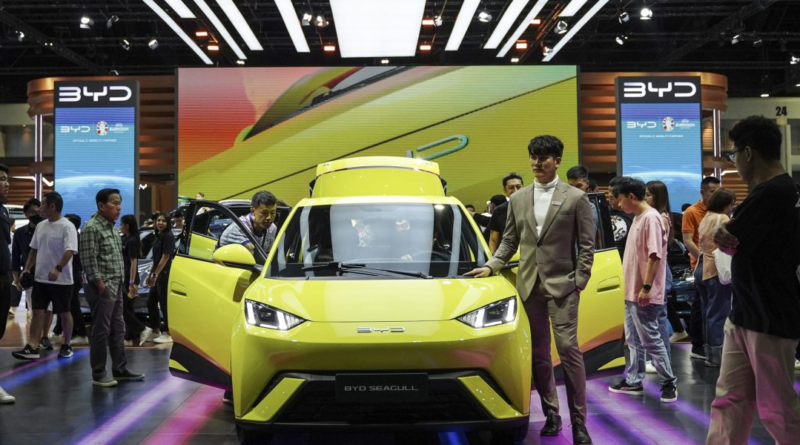China’s $10,000 BYD Seagull hatchback EV is coming for Europe’s carmakers in 2025
Cheap electric vehicles from China are already pushing into Europe, undercutting one of the region’s biggest industries. BYD Co., which overtook Tesla Inc. late last year as the biggest global EV maker, is about to raise the stakes.
The Chinese manufacturer announced plans last month to bring its Seagull hatchback to Europe next year. The car offers premium features like a rotating touch screen and wireless phone charging and sells for less than $10,000 in China. Even after tariffs and modifications to meet European standards, BYD executives expect to sell the Seagull for less than €20,000 ($21,500) on the continent.
That would price the four-seater thousands below electric runabouts that Stellantis NV, Renault SA and others are counting on to help them bridge the energy transition. Its impending arrival is ratcheting up pressure on Europe’s automakers for dominance in the post-combustion engine era. An anti-subsidy investigation by Brussels is unlikely to extinguish the threat.
“We are looking very closely at this model and others coming from Chinese EV makers,” said Martin Sander, head of Ford Motor Co.’s European EV business. “Of course, we are nervous when new competition is coming to the market.”
The Seagull has won plaudits for the build quality, design and technology BYD has packed in for the price. And it’s no one-off: The company plans to introduce a higher-end €25,000 EV before the city car, European Managing Director Michael Shu said at an industry event in London this month. BYD’s plans for two plants in the region will help it blunt the effects of any European Union tariffs meant to slow its path.
The model is already doing well abroad. In Mexico, where the car is dubbed the Dolphin Mini, drivers have been flocking to the 358,800-peso ($19,780) car since its introduction in February, despite patchy charging infrastructure that’s still in its infancy.
Mexico “is not great for us, but in the end we found a lot of demand, a lot of heat for this,” BYD Executive Vice President Stella Li said at an event last week in the capital, unveiling a plug-in hybrid pickup for the Mexican market.
BYD is in the vanguard of Chinese carmakers that are increasingly targeting exports after seizing control of their home market. Tesla CEO Elon Musk warned in January they’ll “pretty much demolish” most other carmakers if trade barriers aren’t erected.
While President Joe Biden has moved to almost quadruple US duties on Chinese EVs, essentially slamming the door on those imports, tariffs are more complicated for Europe. The region’s carmakers are more dependent on the Chinese market than their US counterparts, making them vulnerable to retaliatory measures. Beijing underscored the point on Wednesday, signaling it could unleash tariffs of as high as 25% on imported cars with large engines — a move that would hit Mercedes-Benz Group AG and BMW AG especially hard.
The EU launched a probe of China’s EV industry last year and is nearing a decision on raising levies, but some industry executives and experts have pushed back.
“Tariffs should not be used to shield our lead manufacturers from meaningful competition,” said Julia Poliscanova, senior director for vehicles and e-mobility supply chains at lobby group Transport & Environment. “What matters on top of climate targets, which are critical, is actually to have local jobs and for decarbonization not to result in de-industrialization.”
Founded in 1995, BYD started out making batteries before expanding into autos in 2003. It began selling passenger cars in Europe three years ago and made splashes at both the Paris and Munich auto shows. BYD shares have advanced 9.6% this year after losing 23% in 2023. For now, it’s the former British brand MG Motor that’s leading the charge, after spending years to rebuild its dealer network and customer base since its 2007 acquisition by Shanghai Automotive Industry Corp. It now has the UK’s second-best selling EV with the Chinese-made MG4, behind Tesla’s Model Y.
Incumbent European carmakers are considering unorthodox steps to counter the challenge, including new alliances. Renault is openly shopping around for partners to cut costs on a small-car platform, while Stellantis will start sales in September of cars made through its joint venture with China’s Zhejiang Leapmotor Technologies Ltd.
“We have no intention to let this price band open for our Chinese competitors,” Stellantis Chief Executive Officer Carlos Tavares said last week about the upcoming European Seagull, dismissing calls for tariffs. “We don’t think that protectionism will give us a long-term way out of this competition.”
Tavares has long emphasized acting swiftly to counter foes. The deal with Leapmotor, forged in October, allows the Jeep and Peugeot owner to benefit from China’s cost advantages and advanced EV technology, which the US and EU have said has been propped up by unfair government aid. While the overall share of Chinese brands in Europe’s electric market was around 7% last year, Transport & Environment projects they could reach 11% this year and 20% in 2027.
Judging by the reviews, incumbent automakers in Europe and the US are right to take the Seagull seriously. Caresoft Global, a Michigan engineering firm that tears down vehicles to evaluate quality and manufacturing techniques, pored over the Seagull to assess money-saving details in its construction.
“Everyone in the industry should be talking about this car, seriously, because it’s quite a vehicle,” Caresoft President Terry Woychowski said in a video posted on InsideEVs. “It changes the definition of cheap and cheery, which basically said, ‘Oh, sell something that’s just really cheap.’ This doesn’t come across that way at all.”




